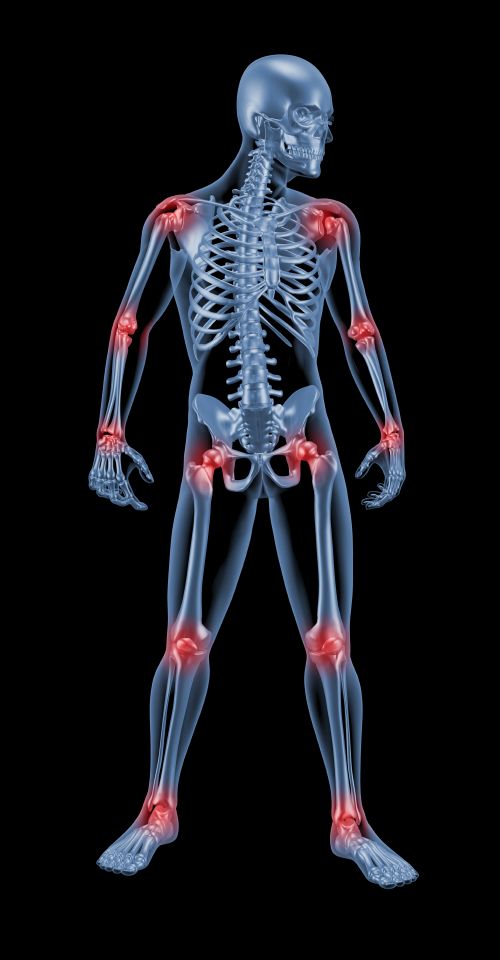
Arthritis, a broad term for joint inflammation, is understood in Ayurveda through various classifications, primarily as a Vata Vyadhi (Vata-dominant disorder), but often involving other doshas and the crucial concept of Ama (toxins). The Ayurvedic approach is holistic, aiming to address the root causes, manage symptoms, prevent progression, and improve overall well-being.
Here’s how Ayurveda classifies and treats different forms of arthritis:
I. Ayurvedic Classifications of Arthritis:
- Amavata (Rheumatoid Arthritis – RA):
- Core Concept: The most common Ayurvedic correlation to RA. It’s caused by the impairment of digestive fire (Agni), leading to the formation of ‘Ama’ (undigested, toxic metabolic waste). This Ama, when combined with vitiated Vata dosha, travels through the body’s channels (srotas) and settles in the joints (and other tissues), leading to inflammation, pain, swelling, and stiffness (especially morning stiffness). Pitta and Kapha can also be involved.
- Symptoms: Migratory joint pain, swelling, stiffness (particularly in the morning), feverishness, malaise, indigestion, loss of appetite. Symmetrical polyarthritis is common.
- Sandhivata (Osteoarthritis – OA):
- Core Concept: Primarily a Vata disorder, associated with degeneration and wear-and-tear of joint tissues (cartilage, bone). It’s common in old age (Vata phase of life) or due to overuse, injury, or nutrient deficiency. Here, Vata’s dry, rough qualities lead to dryness, reduced lubrication (depletion of Shleshaka Kapha), and cracking sounds in the joints.
- Symptoms: Pain that worsens with movement and improves with rest, stiffness (especially after inactivity), crepitus (cracking sounds), limited range of motion. Usually affects weight-bearing joints (knees, hips, spine).
- Vatarakta (Gout):
- Core Concept: Involves vitiation of both Vata and Rakta (blood). Often associated with high uric acid levels (though Ayurveda focuses on metabolic imbalances).
- Symptoms: Sudden, severe pain, redness, swelling, and tenderness in joints (often the big toe), burning sensation.
- Asthigata Vata (Ankylosing Spondylitis – AS):
- Core Concept: Vata affecting bone (Asthi Dhatu) and bone marrow (Majja Dhatu), leading to stiffness and eventual fusion. It can also have Ama and Pitta components.
- Symptoms: Chronic stiffness and pain, primarily in the spine and sacroiliac joints, worsening with rest and improving with activity.
II. General Ayurvedic Treatment Principles for Arthritis:
Regardless of the type, the overarching goals are:
- Ama Pachana (Digestion of Toxins): The primary step, especially in Amavata. Improving digestive fire (Agni) is crucial.
- Vata Shamana (Vata Pacification): Calming the aggravated Vata dosha to reduce pain, dryness, and stiffness.
- Shodhana (Detoxification – Panchakarma): Eliminating deep-seated toxins and balancing doshas.
- Rasayana (Rejuvenation): Nourishing and strengthening the depleted tissues (Dhatus) and promoting tissue repair.
- Reducing Inflammation: Through specific herbs and therapies.
III. Ayurvedic Treatment Approaches (General):
A. Shodhana (Panchakarma – Detoxification and Purification Therapies): These therapies are highly recommended under expert supervision for comprehensive detoxification and restoration of balance.
- Abhyanga (Herbal Oil Massage): Regular massage with warm medicated oils (e.g., Mahanarayana Thailam, Kottamchukkadi Thailam, Dhanwantharam Thailam, Sahacharadi Thailam, Nirgundi Taila, Bala Ashwagandhadi Thailam, Sesame oil). It lubricates joints, tones muscles, improves circulation, reduces pain and stiffness, and pacifies Vata.
- Swedana (Fomentation/Steam Therapy): After Abhyanga, medicated steam baths or localized fomentation are applied. This helps open channels (srotas), reduce stiffness, and relieve muscle spasms. Types include:
- Kizhi (Pinda Sweda): Herbal boluses (poultices) filled with medicated leaves (Elakizhi), powders (Podi Kizhi), or rice (Navarakizhi) are heated and pounded over the affected area. This provides targeted relief, reduces inflammation, and improves blood circulation. Choorna Pinda Sweda (dry powder fomentation) is often preferred in initial stages of Amavata to dry up Ama.
- Pizhichil (Oil Bath Therapy): Continuous pouring of warm medicated oil over the entire body with gentle massage, beneficial for pacifying Vata and nourishing tissues, especially in OA.
- Basti (Medicated Enema): Considered the best treatment for Vata disorders and for expelling Ama from the colon (the primary seat of Vata).
- Sneha Basti (Oil Enema): Administering medicated oils rectally to nourish tissues and pacify Vata.
- Kashaya Basti (Decoction Enema): Administering herbal decoctions to cleanse the colon and further pacify Vata. Both are crucial for systemic detoxification and providing long-term relief.
- Virechana (Therapeutic Purgation): If there’s significant Pitta involvement (e.g., burning pain, inflammation) or Kapha involvement (heaviness, dullness) or stubborn Ama, medicated purgation helps eliminate these toxins.
- Upanaha (Herbal Paste Application): Application of warm herbal pastes to reduce localized pain, swelling, and stiffness.
- Janu Basti / Kati Basti / Greeva Basti: Localized oil retention therapies on the knees, lower back, or neck respectively, where a dam made of dough is filled with warm medicated oil. This deeply nourishes and lubricates the specific joint, reducing pain and improving mobility. Particularly beneficial for OA and localized spondylosis.
B. Shamana (Palliative Therapies & Herbal Medicines):
- Internal Medications: A qualified Ayurvedic practitioner will prescribe specific herbal formulations based on the individual’s dosha imbalance and the specific type of arthritis. Common herbs and formulations include:
- Guggulu Preparations: (e.g., Yogaraja Guggulu, Mahayogaraja Guggulu, Trayodashanga Guggulu, Simhanada Guggulu, Punarnavadi Guggulu) are potent anti-inflammatory, analgesic, and Ama-digesting herbs.
- Ashwagandha (Withania somnifera): Adaptogen, anti-inflammatory, nervine tonic, helps strengthen tissues.
- Shallaki (Boswellia serrata): Strong anti-inflammatory properties, helps reduce joint inflammation and prevent cartilage breakdown.
- Guduchi (Tinospora cordifolia): Immunomodulator, anti-inflammatory, and Ama-digesting, particularly useful in Amavata (RA).
- Rasna (Pluchea lanceolata): Known for Vata-pacifying and anti-inflammatory properties, good for stiffness and pain.
- Nirgundi (Vitex negundo): Analgesic and anti-inflammatory, good for nerve pain and muscle spasms.
- Shunthi (Ginger): Has anti-inflammatory and Ama-digesting properties.
- Haridra (Turmeric/Curcuma longa): Contains curcumin, a strong anti-inflammatory and antioxidant.
- Triphala: Detoxifying, mild laxative, helps eliminate Ama.
- Eranda (Castor oil): Used for Vata-pacifying and purgative properties, helps relieve stiffness and eliminate Ama.
- Classical formulations: Mahanarayana Thailam (external), Ksheerabala Thailam (internal/external), Rasnairandadi Kashayam, Dashamoolarishtam, Balarishtam.